Think dinosaurs and the first thing most of us imagine is a large two-legged carnivore with 15-cm teeth, power-shovel jaws and dinky forelimbs. A beast of prey that spent most of the Upper Cretaceous going ‘raaargh’ and having absolutely anything it wanted for breakfast.
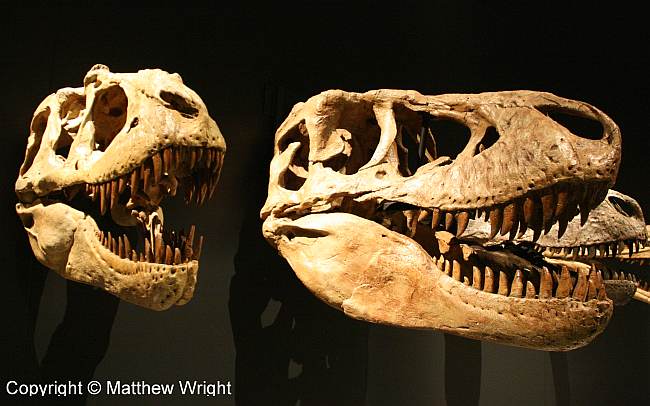
It was thanks to those jaws and 6-metre body that Tyrannosaurus Rex – named such in 1905, over a decade after the first fossils were discovered – was captured by popular imagination well before it became the surprise anti-hero in Jurassic Park.
Never mind the fact that – if we DID meet one, Lost World-style, a bullet or two would turn the hungriest T-Rex into T-Rug. Still, the point that humans are Earth’s all-time apex predator didn’t stop T-Rex speaking to nineteenth and early twentieth century concepts of animal machismo. It was still one of the most dangerous animals to walk this planet. And that made it scary to imagine a meeting. Especially for someone not equipped with a Remington Model 700 BDL. Or running shoes.
Part of the magic came about because Tyrannosaurs died out at the end of the Cretaceous, some 65 million years ago. And that remove in time has given them mythic status. We know them only through bones. Our imagination fills the gaps. And that’s why we keep re-inventing them, even as science and new discoveries, together, unravel an increasingly clear picture of what they were like.

Let me explain. To nineteenth and early twentieth century science, dinosaurs were scaly, lumbering, tail-dragging reptiles of which the most ferocious – and certainly the hungriest – was the Tyrannosaurus Rex. That name, ‘King of the tyrant lizards’, said it all.
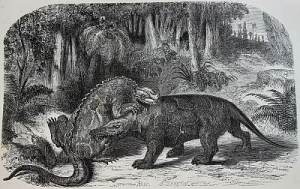
The image came out of nineteenth century ideas of ‘progression’ and the ‘tree of life’ (a pre-Darwinian notion) which helped shape popular concepts of evolution as directional ‘advance’ from reptiles to dinosaurs to mammals, each ‘superior’ to the last and thus dooming its dull-witted predecessor to extinction. It was a mind set that took decades to shake – hence the dispute in the 1980s over whether dinosaurs generated internal heat endothermically, like mammals and birds, as asserted by Robert Bakker.
The actual answer, of course, was staring us in the face all along – and Bakker was right, though it wasn’t until the early twenty-first century that enough fossil evidence had been collected to convince the whole scientific community.
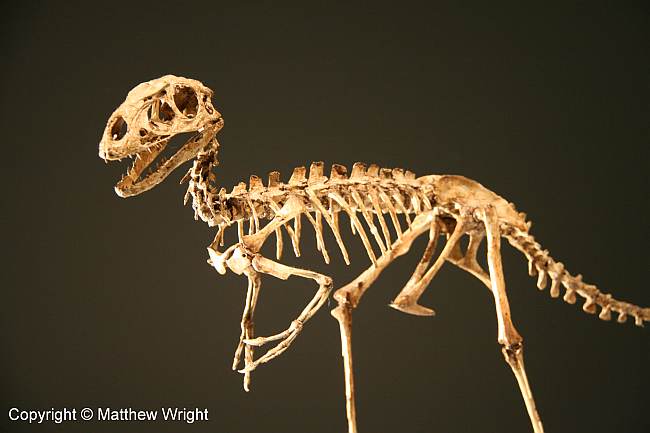
We’d known for a while that birds were related to dinosaurs – specifically, theropods, which is the same dinosaur group T-Rex hails from. But the truth didn’t emerge until the early 1990s when increasing numbers of fossils were found in China with clear feather impressions. All, initially, were theropods – the bird ancestors and cousins. But then, earlier this year, a dinosaur species not associated with the bird descent line was found to be also feathered.
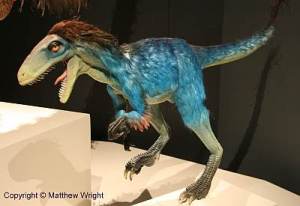
The old idea of dinosaurs as reptiles had already been under fire. And suddenly the truth became obvious. They weren’t reptiles at all. Dinosaurs, like birds, were feathered. Not for flight, mostly, but for insulation – and, doubtless, display. Not only that, but we already knew dinosaurs all had the same skull structure as birds, the same specific skeletal features including pneumatised bones – and half the dinosaurs were, in fact, bird-hipped. They laid eggs in nests. And if it looks like a bird and tastes like a bird… Well, the reality is that birds aren’t descended from dinosaurs. They are dinosaurs. We’ve even discovered the genes inside the chicken genome that atavistically give chickens dino-jaws with teeth, instead of a beak.
The fact that birds are surviving dinosaurs resolves a lot of questions. Want to know how dinosaurs lived? Look out the window at sparrows. Want to know if they were endothermic? Stick a thermometer in a chicken’s – er, well, anyway, you get the idea.
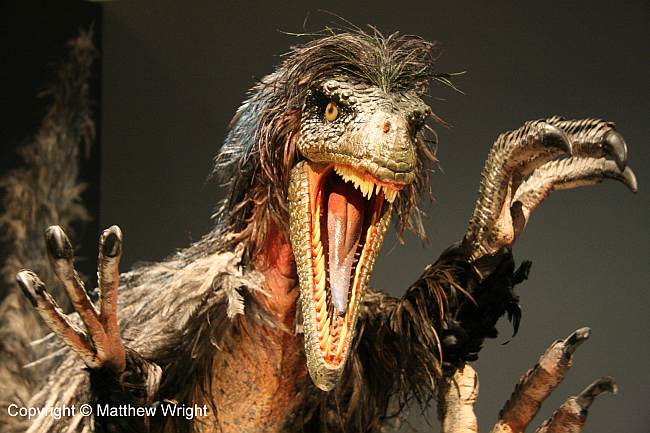
As for our King of the Tyrant Lizards? Well, it turns out that T-Rex was among the last of a long family of Tyrannosaurs, not all of which were quite as big and ferocious as the Big Guy. They all had feathers – not for flight, but for insulation. They all laid eggs. They were all bipedal. And their tails didn’t drag – tendons kept them agile. If you met one, you might think it was a funny looking bird. One that wanted you for lunch.

Of course the world of the dinosaurs is long gone – not because they were doomed to be out-evolved, but because their environment changed, literally with a bang. And that comet-driven extinction, 65 million years ago, didn’t just kill dinosaurs. It killed just about everything. Of the dinosaurs, only flying examples – the birds – survived.
All this was brought home for me, graphically and with a lot of special effects, when I went to check out an interactive exhibition in Te Papa Tongarewa, New Zealand’s National Museum. It’s where the first Iguanadon bone ever found is held – it was brought to New Zealand in the 1840s by Walter Mantell, son of the discoverer – and it’s where I took these photos. And if you want to see me personally dodging Tyrannosaurs and see others prancing along the Wellington waterfront – well, I took some photos…
More soon.
Copyright © Matthew Wright 2014
Awesome! Dinosaurs are among my favorite subjects. You’re right in making the distinction that birds aren’t related to dinosaurs…the ARE dinosaurs. Dinosaurs didn’t really fail in an evolutionary sense since. Their design is the most successful in the history of earth (well, maybe sharks and crocodiles are more successful. Perhaps even the Horseshoe Crab). I think I might make one criticism, though. From my investigations, the Velociraptor is quite small, about 3 feet tall. Although a pack of them could easily bring down a Human for breakfast. The Utah Raptor, on the other hand, could look a football player straight in the eye. And then they hunt in packs too. Yikers!
LikeLike
The notion of being attacked by a pack of raptors – yikes, absolutely! well, my “Lost World” weapon of choice would have to be a 12 gauge pump action with at least one deerslug in the magazine…
Apropos size, yes I agree – the information I’ve got says Velociraptor was about the size of a large vulture. And I’ve seen reconstructions (with feathers) to that size.
However, I made the comment off this model which was a lot larger. It came from Sydney – I’d seen it before in the NSW Museum – and given that they’d put Dilong at life-size plus the chicken for scale, I had to suppose it too was life-size. I have another pic I took with someone beside it, which I’ll publish with the next post as a handle on the size of the model. It’s possible they modelled Deinonychus, which was similar but larger, and it’s been mislabelled in this exhibition.
Actually, Velociraptors being vulture size underscores something we forget – we focus our imaginations on the relative handful of very large dinosaurs, whereas the reality was that most were smaller than we are, often by quite a bit. Rather – er – bird-like in every respect. Stands to reason given food supply issues, which of course renders the T-Rex even more unusual. On matters of scale, I’ve got a photo yet to publish (next week) of a virtual Courelosaur checking out my camera during the extremely cool and very high-tech “interactive” part of the exhibition.
LikeLiked by 1 person
That’s an excellent point. The huge dinosaurs are truly impressive and they get all the press, but the bulk of them were quite small. And even though Velociraptor was small, I imagine a pack would have no trouble bringing a human down. I’ll take one of those assault shotguns with the rotary magazine. 😉
There were many kinds of raptors, or Dromeosaurs (same family), and they came in many different sizes. The Megaraptor was 12 feet tall if I recall correctly. At the same time most Troodons were very small, but those in the polar regions were far larger and their normal prey was Edmontosaurus. Anything that can bring down a 40-foot herbivore is no slouch!
Looking forward to more of your pics! 🙂
LikeLike